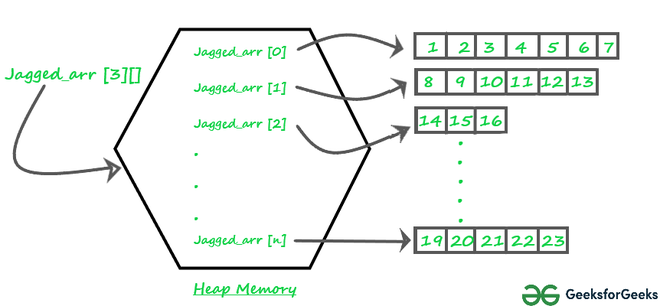Jagged Array in Java
Last Updated :
05 Feb, 2023
Prerequisite: Arrays in Java
A jagged array is an array of arrays such that member arrays can be of different sizes, i.e., we can create a 2-D array but with a variable number of columns in each row. These types of arrays are also known as Jagged arrays.
Pictorial representation of Jagged array in Memory:

Jagged_array
Declaration and Initialization of Jagged array :
Syntax: data_type array_name[][] = new data_type[n][]; //n: no. of rows
array_name[] = new data_type[n1] //n1= no. of columns in row-1
array_name[] = new data_type[n2] //n2= no. of columns in row-2
array_name[] = new data_type[n3] //n3= no. of columns in row-3
.
.
.
array_name[] = new data_type[nk] //nk=no. of columns in row-n
Alternative, ways to Initialize a Jagged array :
int arr_name[][] = new int[][] {
new int[] {10, 20, 30 ,40},
new int[] {50, 60, 70, 80, 90, 100},
new int[] {110, 120}
};
OR
int[][] arr_name = {
new int[] {10, 20, 30 ,40},
new int[] {50, 60, 70, 80, 90, 100},
new int[] {110, 120}
};
OR
int[][] arr_name = {
{10, 20, 30 ,40},
{50, 60, 70, 80, 90, 100},
{110, 120}
};
Following are Java programs to demonstrate the above concept.
Java
class Main {
public static void main(String[] args)
{
int arr[][] = new int[2][];
arr[0] = new int[3];
arr[1] = new int[2];
int count = 0;
for (int i = 0; i < arr.length; i++)
for (int j = 0; j < arr[i].length; j++)
arr[i][j] = count++;
System.out.println("Contents of 2D Jagged Array");
for (int i = 0; i < arr.length; i++) {
for (int j = 0; j < arr[i].length; j++)
System.out.print(arr[i][j] + " ");
System.out.println();
}
}
}
|
Output
Contents of 2D Jagged Array
0 1 2
3 4
Following is another example where i’th row has i columns, i.e., the first row has 1 element, the second row has two elements and so on.
Java
class Main {
public static void main(String[] args)
{
int r = 5;
int arr[][] = new int[r][];
for (int i = 0; i < arr.length; i++)
arr[i] = new int[i + 1];
int count = 0;
for (int i = 0; i < arr.length; i++)
for (int j = 0; j < arr[i].length; j++)
arr[i][j] = count++;
System.out.println("Contents of 2D Jagged Array");
for (int i = 0; i < arr.length; i++) {
for (int j = 0; j < arr[i].length; j++)
System.out.print(arr[i][j] + " ");
System.out.println();
}
}
}
|
Output
Contents of 2D Jagged Array
0
1 2
3 4 5
6 7 8 9
10 11 12 13 14
Example
Java
import java.util.Scanner;
public class JaggedArray {
public static void main(String[] args) {
Scanner scan = new Scanner(System.in);
System.out.print("Enter the number of sub-arrays: ");
int numberOfArrays = scan.nextInt();
int[][] jaggedArray = new int[numberOfArrays][];
for (int i = 0; i < numberOfArrays; i++) {
System.out.print("Enter the size of sub-array " + (i + 1) + ": ");
int sizeOfSubArray = scan.nextInt();
jaggedArray[i] = new int[sizeOfSubArray];
}
for (int i = 0; i < numberOfArrays; i++) {
System.out.println("Enter the elements of sub-array " + (i + 1) + ":");
for (int j = 0; j < jaggedArray[i].length; j++) {
jaggedArray[i][j] = scan.nextInt();
}
}
System.out.println("The jagged array is:");
for (int i = 0; i < numberOfArrays; i++) {
for (int j = 0; j < jaggedArray[i].length; j++) {
System.out.print(jaggedArray[i][j] + " ");
}
System.out.println();
}
scan.close();
}
}
|
Jagged arrays have the following advantages in Java:
- Dynamic allocation: Jagged arrays allow you to allocate memory dynamically, meaning that you can specify the size of each sub-array at runtime, rather than at compile-time.
- Space utilization: Jagged arrays can save memory when the size of each sub-array is not equal. In a rectangular array, all sub-arrays must have the same size, even if some of them have unused elements. With a jagged array, you can allocate just the amount of memory that you need for each sub-array.
- Flexibility: Jagged arrays can be useful when you need to store arrays of different lengths or when the number of elements in each sub-array is not known in advance.
- Improved performance: Jagged arrays can be faster than rectangular arrays for certain operations, such as accessing elements or iterating over sub-arrays, because the memory layout is more compact.
It’s important to note that jagged arrays also have some disadvantages, such as increased complexity in the code and a potentially less readable codebase, so they should be used carefully and appropriately.
Like Article
Suggest improvement
Share your thoughts in the comments
Please Login to comment...